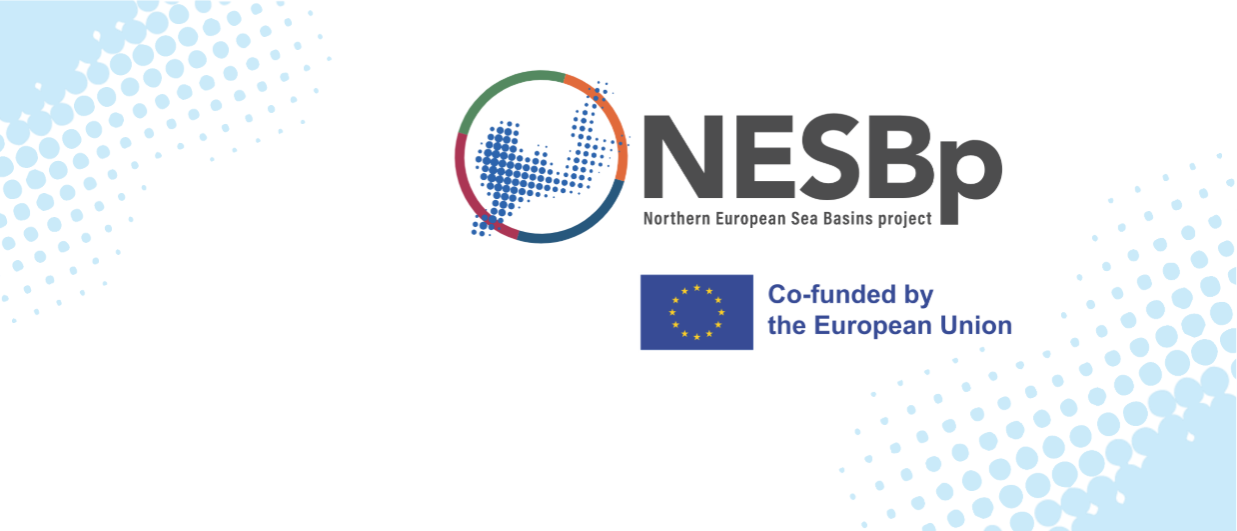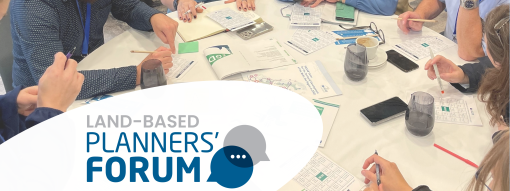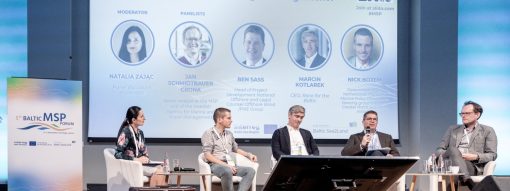Achievements of the NESB project gap analysis and strategy development phase
The Northern European Sea Basins project (NESBp) has successfully completed its initial phase – gap analysis and strategy development phase – and is now entering its next stage: implementation at the mapping phase. During the gap analysis phase, project partners worked across four thematic work packages to assess existing conditions, identify critical challenges, and lay the groundwork for further project implementation.
What has been achieved so far, and what lies ahead? Here’s a closer look at the key developments in each of the four work packages.
WORK PACKAGE – OCEAN GOVERNANCE
Scoping Themes and Formats for Cross-Sea Basin Dialogue
During the gap analysis phase, partners contributing to Work Package Ocean Governance focused on several directions, one of which was scoping themes and formats to launch and test-run a cross-sea basin dialogue between the Baltic and North Sea regions. Initial discussions were held separately within each sea basin, through the GNSBI Steering and Technical Group meetings and the HELCOM-VASAB MSP Working Group meetings. These indicated a shared interest in exchanging approaches on strategic planning (e.g., regional goal setting and prioritization), early stakeholder engagement, and cross-sectoral coordination for the planning and management of various maritime activities.
Towards a Shared Understanding of Governance Approaches
Central to the discussions during these same meetings was the development of a shared understanding of governance approaches—particularly how to integrate ecosystem-based management (EBA) and cumulative impact assessment (CIA) methods across borders and between both regions. It is worth mentioning that the recently revised Guideline for the Implementation of the Ecosystem-Based Approach in Maritime Spatial Planning (MSP) in the Baltic Sea Area—developed within the HELCOM-VASAB MSP WG—is now complete. This document is a key contribution to the Baltic Sea Regional MSP Roadmap 2021–2030 and provides a solid basis for deeper cross-basin discussion and learning in the next project period.
The same discussions also identified practical topics of shared interest for MSP practitioners from both sea regions. These include sustainable approaches to offshore renewable energy development, integrated climate resilience, and the need for improved data sharing and harmonization efforts. The next project period is expected to include several events to realize dialogue on these identified priorities and interests.
Assessing Existing Cooperation for Transboundary Governance
Another direction explored during the gap analysis phase was aimed toward the objective of enhancing the effectiveness of transboundary governance. To support this, existing cooperation formats, organizations, and mechanisms in both sea regions were scoped and mapped. This resulted in a typology assessed by effectiveness and impact, providing a basis for deeper analysis. Examples of mapped cooperations include the OSPAR Commission, the North Seas Energy Cooperation, the HELCOM Commission, VASAB, the HELCOM-VASAB MSP WG, the MSP Planners’ Forum, and the Baltic MSP Forum. This assessment, along with upcoming expert interviews, will serve as input for the governance scenarios to be developed for the Greater North Sea Basin in the next phase of the project.
WORK PACKAGE – MULTI-USE IN PRACTICE: FROM MARIPARKS TO BASIN-SCALE MULTI-USE
First Results from the Gap Analysis Phase: Laying the Foundation for Mariparks
At the core of the work packages’s work lies the concept of Multi-Use and the emerging model of Mariparks—a central theme that has been now clearly defined and framed for future development.
What is a Maripark?
A clear working definition of what is meant by a Maripark has been developed:
“A Maripark can take many forms—ranging from the co-location of two activities to a fully integrated, multi-use business infrastructure or a shared sea space. It creates synergies by enabling industries to share infrastructure, governance, security, monitoring, and smart services, reducing costs and risks for offshore operations.”
In the North Sea, Mariparks have the potential to unlock synergies across offshore energy, aquaculture, shipping, research, and other blue economy sectors. By integrating AI, digital twins, and autonomous systems, they can significantly boost operational efficiency while contributing to the energy transition, food security, and biodiversity restoration.
Developing Scenarios for Multi-Use Settings
One of the major outcomes of the gap analysis phase is the development of a structured terminology and framework to support scenario building. Recognizing that Multi-Use can occur in various contexts, three primary Maripark settings were identified:
- Stand-alone infrastructure;
- Integration within an operational wind farm;
- Installation in a decommissioned wind farm area.
Each of these settings is being developed by working with real-world case locations, which will serve as the basis for scenario development and validation during the implementation phase.
Governance: Aligning With Existing and Emerging Models
Assessment of governance models suitable for Mariparks has been initiated. This includes exploring compatibility with established marine governance approaches such as co-management, adaptive governance, and ecosystem-based spatial planning.
Additionally, comparison of market-based governance models (with environmental safeguards) and polycentric governance structures that emphasize decentralization and multi-level coordination has been started.
Data and Monitoring Foundations
On the data side, work was focused on two main areas:
- Baseline studies and data management, including a comprehensive literature review on Multi-Use platforms and related initiatives;
- (Smart) monitoring approaches, to support operational safety, efficiency, and environmental sustainability.
These insights will guide scenario validation and inform data strategies as project moves forward.
Towards a Maripark Blueprint
All of these developments are converging in the initial formulation of a Maripark blueprint. This evolving framework is already shaping the selection of case studies and was used to design the first stakeholder workshop in July 2025.
Read more about the NESB project: www.NESBproject.eu
Co-funded by the European Union. Views and opinions expressed are however those of the project consortium only and do not necessarily reflect those of the European Union or CINEA. Neither the European Union nor the granting authority can be held responsible for them.
WORK PACKAGE – ENERGY TRANSITION AND BIODIVERSITY IN MARITIME SPATIAL PLANNING
Developing a Shared Terminological Glossary
The development of a terminological glossary is the task where terms utilized for identification of various aspects of energy transition and nature conservation in maritime spatial planning (e.g. MPAs, MSP systematic in designations, mitigation hierarchy, responsibilities, etc.) will be collated and an overview of this terminology will be performed. Its implementation was launched by a workshop on 29 April 2025 that aimed at the scoping and frame-setting of the task. During the gap analysis phase topics for glossary were outlined, sources of information (e.g. EU directives, regional recommendations, etc) identified, collaborative framework set, and timeframe defined. Analysis of potential users revealed high demand for such a glossary. Particularly, it might become an integral part of a dynamic glossary, which is planned to be established in HELCOM community.
Compiling a Catalogue of Mitigation Measures
The work on a catalogue of mitigation measures starts from an overview of actions for enhancement of nature conservation in MSP. Sources of information for the overview have been identified and a connection to the currently running work in the NSEC SG2 on mitigation measures was established. The main sources of information are the outcomes of MSP4BIO project and scoping work of PROTECT Baltic project, which jointly provides a comprehensive insight into potentially foreseeable conservation and restoration measures. It is to be complemented by a compilation of respective measures envisaged in existing national MSPs in the North and Baltic Sea regions. A questionnaire to collect the information needed has been developed and potential respondents have been identified. This overview will lay basis for subsequent analysis of potential application of these measures to mitigate environmental pressures and their systematization for the catalogue.
Advancing Cumulative Impact Assessment at Sea Basin Level
The task on cumulative impact assessment at North Sea Basin level has been started with the development of a procurement procedure in collaboration with GNSBI work track on CIA and ICES. The development was accomplished and the procedure launched. Additionally, complementary work in the Baltic Sea has been identified. This is a recently approved INTERREG project aimed at the development of regional SEA framework, where CIA methodology plays a crucial role. First contacts between these two processes have been established and framing cooperation agreement achieved.
WORK PACKAGE – KNOWLEDGE TRANSFER & SHARING
Addressing Data and Knowledge Challenges in European MSP
This Work Package focuses on addressing the informational and knowledge-related challenges, in the context of “digital turn” and sea basin coordination perspectives into European MSP processes. It explores how data, information and knowledge (DIK(W)) are structured, shared, and made usable across the different national MSP frameworks in the NESBp perimeter (13 countries under the GNSBI and HELCOM scopes).
The gap analysis phase reveals as broad elements to consider: an amount of MSP data fragmented, which produces partial (geographic) information and therefore constructs heterogeneous understandings of it, thus creating disparities in knowledge needed for an MSP decision-making process adapted to the uncertain context of our modern world.
The core challenge is not about producing more data (even it could be relevant for certain activities as fisheries or topics as CC impacts), but more about improving the Data-Information-Knowledge assemblage, with the key step of information often forgotten or even missing. The aim is to make MSP processes more resilient, transparent and future-oriented.
What Specific Aspects of the Informational and Knowledge-Related Challenges Did Each Task Explore?
- Evaluation of national plans consistency on maritime safety stakes for sea-basin coordination. The task assessed the types of national MSP plans and geoportals, using literature-based indicators to establish a baseline for evaluating the coherence of the maritime safety dimension across the national MSP initiatives in the NESBp countries. Within the DIK(W) approach, maritime safety is treated as a cross-thematic dimension that enables the exploration of data–information–knowledge challenges in MSP. Based on the types of MSP plans and geoportals identified, the next steps will focus on analyzing how maritime safety is integrated into various types of MSP plans and geoportals, with the goal of improving the spatial decision-support tool for maritime safety in MSP-Navisafe.
- Strengthen data services in EMODnet for MSP stakeholders. This task compared the EMODnet datasets that are available online (mainly in the map viewer) with the 7 data clusters of the Maritime Spatial data Framework produced by the TEG and detailed by Shom. This detailed comparison reveals strong coverage of environmental data layers, but also highlights gaps in socio-economic and governance-related datasets in EMODnet, along with inconsistencies in metadata, tagging, and taxonomy. The next step will focus on enhancing EMODnet’s capacity to serve as a key provider of high-quality MSP data and information, acknowledging its crucial role in supporting the development of the EDITO projects.
- Geographic dashboard/synthetic map. The task introduced a quality assessment grid for evaluating the information provided by national MSP geoportals, aiming to define geographic reference layers and associated dashboards to enhance transparency and public communication. The next step will involve applying this assessment to identify relevant shareholders and stakeholders within the NESBp perimeter.
- Development of knowledge-sharing platform. The task assessed regional North Sea and European geoportals using several criteria to help lay the foundation for the much-needed GNSBI knowledge-sharing platform, which will support cross-border consistency and long-term learning across the Greater North Sea Basin.
The Way Forward: From Raw Data to Actionable Knowledge
Bridging the gap between raw data and actionable knowledge, particularly through improved geoportal content and design, better metadata quality, the respect of the European norms (e.g. INSPIRE) and international standards/principles (e.g. FAIR, Internation Hydrographic Organisation), will be the key for supporting an effective and adaptive MSP in the years ahead.




